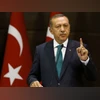In a major weapons purchase deal, the US Defense Security Cooperation Agency has approved the possible sale of AIM-120C-8 Advanced Medium-Range Air-to-Air Missiles to the Republic of Turkiye at an estimated cost of $225 million. This includes not just the missiles but also a support package covering logistics and program assistance, according to an official statement by the US Defense Security Cooperation Agency (DSCA) on Wednesday.
The agency said it has delivered the required certification notifying Congress of this possible sale on May 14.
The development came after NATO ally Turkiye requested to buy 53 AIM-120C-8 Advanced Medium Range Air-to-Air Missiles (AMRAAM) and six AIM-120C-8 AMRAAM guidance sections.
“This proposed sale will support the foreign policy goals and national security of the US by improving the security of a NATO ally that continues to be a force for political and economic stability in Europe,” said the DSCA statement.
The DSCA further detailed that these items will also be included in weapons sale deal: AMRAAM containers and support equipment; Common Munitions Built-in-Test (BIT) Reprogramming Equipment (CMBRE); spare parts, consumables and accessories, repair and return support; weapons system support and software; classified software delivery and support; classified publications and technical documentation; transportation support; studies and surveys; US Government and contractor engineering, technical, and logistics support services; and other related elements of logistics and programme support.
Also Read
How will this strengthen Turkiye’s air defense capabilities?
This purchase is expected to strengthen Turkiye's air defense, which has been a key area of investment in its military modernisation efforts. Like India, Turkiye also bought an S-400 air defence system from Russia in 2019, for which the US was not happy at that time. The S-400 is considered one of the most sophisticated air defence systems in today’s time.
“This proposed sale will provide Turkiye with a critical air defense capability to assist in defending its homeland and US personnel stationed there. Turkiye will have no difficulty absorbing these articles and services into its armed forces,” the DSCA mentioned. It emphasised that the proposed sale of this equipment and support will not alter the basic military balance in the region.
What does the US-Turkiye arms trade history look like?
Historically, Turkiye and the US have criticised each other on various issues from time to time. More importantly, regarding the issue of an independent Palestinian state, Turkiye’s President Recep Tayyip Erdogan has openly blamed the US on several occasions for supporting Israel, which is further deepening the ongoing crisis. Interestingly, this has not affected US-Turkiye relations, and Turkiye continues to purchase weapons from the US.
Turkiye has bought many weapons and military systems from the US over the years as part of their NATO partnership.
These include a large number of F-16 fighter jets, which form the backbone of the Turkish Air Force. Turkiye also used older US planes like the F-4 Phantom and helicopters such as the Black Hawk and Chinook. They were once part of the F-35 stealth jet program, but the US removed Turkiye from the project in 2019 after it bought a Russian air defense system S-400.
What other US military systems has Turkiye acquired?
In addition to air force assets, Turkiye’s naval and land forces also rely significantly on US-origin equipment:
Navy: Ships like the Oliver Hazard Perry-class frigates
Army: Tanks such as the M60 Patton, armored vehicles like the M113, and artillery systems
Missiles: Beyond AMRAAM, also Sidewinder and Maverick for jets and helicopters
Moreover, the US has contributed to Turkiye’s defense posture through military aid, training, and tech-sharing, with transport planes like the C-130 Hercules and KC-135 tankers for refuelling.
While Turkiye now builds many of its own drones, it earlier worked with the US on surveillance UAVs. Relations between the two countries have seen ups and downs, especially after 2019, but defense ties still continue through sales, upgrades, and shared NATO operations.

)